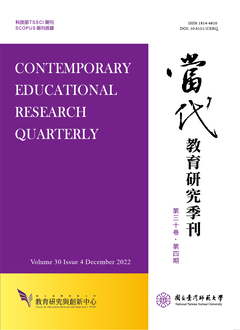

研究目的
本研究旨在應用CVIPP(Context, Vision, Input, Process, Product)政策評估模型,針對臺灣樂齡教育政策於樂齡學習中心之實施成效進行全面評估,並探討其影響因素。研究聚焦樂齡學習中心,因其為政策施行最久、涵蓋面最廣、參與人數最多之核心單位,具有代表性與評估價值。研究目的包括:(一)應用 CVIPP模型檢視政策實施成效;(二)分析影響產出成效的關鍵因素;(三)提出強化政策機制之具體建議。
研究設計/方法/取徑
本研究採用問卷調查法,應用由德懷術建構之CVIPP 評估模型,共涵蓋六層面、十三構面、五十六項指標。研究團隊針對全臺 369所樂齡中心進行抽樣,發放1,840 份問卷,回收有效問卷1,099 份(有效率59.72%)。研究工具整體信度介於.72 至.94,因素負荷量介於.57至 .91。分析方法包括 Z 分數比較、描述統計與階層多元迴歸,用以探究各構面表現與影響產出結果之主要因素。
研究發現或結論
研究結果顯示,政策整體實施成效具備正向表現,其中「課程推動」與「活動執行」指標得分較高;惟在「行銷推廣」、「志工成長」、「經費投入」及「法規制度」等面向仍有改善空間。迴歸分析指出,願景目標明確度、組織運作成熟度及行銷策略為影響實施成效之重要因素。指標交叉分析亦指出,實務面應持續強化之構面有 10 項,宜加強輔導者有 7 項,急需檢討者有 2 項。研究亦指出經費與制度法規基礎薄弱為主要結構性瓶頸。
研究原創性/價值
本研究為國內首度系統性應用 CVIPP 模型評估樂齡教育政策於地方機構之落實成效,並整合願景層面與多元實證資料,除補足既有研究對政策層面探討之不足外,亦提供可操作之實證評估架構,具學術與實務應用雙重價值。透過量化模型評估與迴歸分析,明確揭示政策推動與組織績效間的連動關係,提供後續政策設計與學術研究重要依據。
教育政策建議或實務意涵
建議教育主管機關應強化經費投入、法規制度建構與獎勵機制,以提升專業素養及支撐高齡教育之永續發展。實務上,樂齡學習中心宜加強願景引導、組織明確分工與培育志工,並結合在地資源發展多元行銷策略,擴大與社區之連結與影響力,提升整體營運效能與教育影響力。
Purpose
This study applied the CVIPP (Context, Vision, Input, Process, Product) policy evaluation model to comprehensively assess the implementation effectiveness of Taiwan’s active aging education policy in senior learning centers, and to identify its key influencing factors. Senior learning centers were selected as the focal units due to their long-standing operation, broad geographic coverage, and high participant engagement, offering both representativeness and evaluative value. The study aimed to (1) assess the policy’s implementation outcomes via the CVIPP framework, (2) analyze critical factors influencing its effectiveness, and (3) propose concrete recommendations for enhancing the policy mechanism.
Design/methodology/approach
A questionnaire survey was designed based on a CVIPP evaluation model developed using the Delphi technique, comprising six domains, thirteen constructs, and fifty-six indicators. Stratified sampling was conducted across 369 senior learning centers in Taiwan, with 1,840 questionnaires distributed and 1,099 valid responses collected (response rate: 59.72%). The instrument demonstrated robust reliability (Cronbach’s α ranging from .72 to .94) and adequate factor loadings (.57 to .91). Analytical methods included Z-score comparisons, descriptive statistics, and hierarchical multiple regression to explore performance across dimensions and identify major factors influencing outcome indicators.
Findings/results
The results indicated overall positive policy implementation performance. Higher scores were found in curriculum promotion and activity execution, while areas such as marketing and outreach, volunteer development, financial investment, and regulatory systems showed room for improvement. Regression analysis identified clarity of vision, organizational maturity, and marketing strategies as significant predictors of policy effectiveness. A cross-analysis of indicators revealed ten constructs requiring sustained reinforcement, seven in need of enhanced guidance, and two demanding urgent review. Structural issues especially insufficient funding and underdeveloped regulatory frameworks emerged as major bottlenecks.
Originality/value
This study is the first in Taiwan to systematically apply the CVIPP model to evaluate the localized implementation of active aging education policy. By integrating vision-level analysis with diverse empirical data, it addresses a notable gap in prior research that lacked policy-level focus. The study also presents a replicable empirical evaluation model with academic and practical significance. The use of quantitative modeling and regression analysis further clarifies the linkage between policy implementation and organizational performance, providing a robust foundation for future research and policy design.
Implications for policy/practice
It is recommended that educational authorities strengthen financial investment, regulatory system development, and incentive mechanisms to enhance professional capacity and support the sustainable growth of active aging education. Practically, senior learning centers are advised to reinforce vision-guided planning, establish clear organizational roles, cultivate volunteer development, and leverage local resources to implement diverse marketing strategies—thereby deepening community engagement and improving both operational and educational effectiveness.

本著作係採用創用 CC 姓名標示-非商業性 3.0 台灣 授權條款授權.
本刊國立台灣師範大學教育研究與創新中心
106台北市和平東路一段162號 | 電話: 02-7749-3670 | E-mail: cerecerq@gmail.com
教創中心 | 師大 | 電子報 | 線上投審系統
本刊由國家科學及技術委員會人文社會科學研究中心補助經費
© 2014 CERI-NTNU
